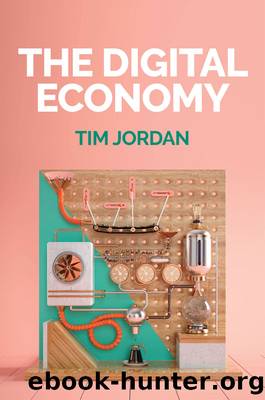The Digital Economy by Tim Jordan

Author:Tim Jordan [Jordan, Tim]
Language: eng
Format: epub
Publisher: Wiley
Published: 2020-01-04T00:00:00+00:00
The new monetisation strategy is to give away for free the software or client that players need to access the platform and play the game. Once a group of players is created then monetisation may proceed relying entirely on in-game and other transactions. Although, as mentioned, WoW offers various purchases in addition to subscription, it is perhaps not surprising that, given its subscriber numbers, it has not pursued this model. One example of an MMOG game that has done so is Rift, which started using the purchase-plus-subscription model but shifted to a free-to-play monetisation strategy.
Rift is very similar to WoW in its structure and first emerged as one of a series of expected ‘WoW-killers’, none of which ever achieved WoW’s level of success.4 It was again set in a broad swords and sorcery world, with PVP and PVE divided and the latter based on complex encounters with AI-run monsters (similar to WoW). The game launched in March 2011 and claimed to have gained 1 million users by August that year and to have generated $100 million in revenue in its first year. It also admitted to having spent just over $50 million to develop the game, and a year after launch claimed to have raised $85 million to invest in further development (Makuch 2012; Graft 2011). Unfortunately, as a private company, it is difficult to find information on subscriber numbers or profitability for Rift or the company that owns it, TrionWorlds. What happened next is that after what seemed a strong start in 2011, the company moved Rift to a free-to-play model in 2013, allowing the whole game to be played for free but with in-game purchases for some gameplay items and for various pets and cosmetic items. It also developed a ‘patron’ model, which offered various gameplay benefits – such as faster movement, quicker gaining of gold and the like – if players took out a subscription. Rift publicity was always clear that if you played for free you would be able to experience all of the game, though completing it might take longer if no payments were ever made. Coming full circle in 2018, it was announced that Rift would offer a separate subscription-only server, returning part of its world to the original subscriber model, and sparking much debate over whether the free-to-play model was itself failing. Rift’s decision to offer both a free-to-play and a subscription model was partly driven by player demand for the latter, often articulated by players as being a better way to play because subscriptions put all players on an even footing (Machekovech 2018).
Free-to-play is thought to offer potential profitability because it can generate larger numbers of players who are happy to pay for various benefits in a game even if benefits are only cosmetic, such as a distinctive hat. Free-to-play relies on micro-transactions, which involves keeping individual sales relatively low cost so that players do not feel they are paying too much each time they decide to pay for an item, such as a hat, or not.
Download
This site does not store any files on its server. We only index and link to content provided by other sites. Please contact the content providers to delete copyright contents if any and email us, we'll remove relevant links or contents immediately.
Rich Dad Poor Dad by Robert T. Kiyosaki(6506)
Pioneering Portfolio Management by David F. Swensen(6253)
How To Win Friends and Influence People by Dale Carnegie(4470)
The Money Culture by Michael Lewis(4130)
The Dhandho Investor by Mohnish Pabrai(3721)
The Wisdom of Finance by Mihir Desai(3692)
Liar's Poker by Michael Lewis(3412)
Fooled by Randomness: The Hidden Role of Chance in Life and in the Markets by Nassim Nicholas Taleb(3079)
The ONE Thing by Gary Keller(3031)
The Intelligent Investor by Benjamin Graham Jason Zweig(3010)
Mastering Bitcoin: Programming the Open Blockchain by Andreas M. Antonopoulos(3006)
Rich Dad Poor Dad: What The Rich Teach Their Kids About Money - That The Poor And Middle Class Do Not! by Robert T. Kiyosaki(2928)
How to Day Trade for a Living: Tools, Tactics, Money Management, Discipline and Trading Psychology by Andrew Aziz(2924)
Investing For Dummies by Eric Tyson(2920)
How to Win Friends and Influence People by Dale Carnegie(2883)
The Psychology of Money by Morgan Housel(2789)
Market Wizards by Jack D. Schwager(2669)
Zero Hour by Harry S. Dent Jr. & Andrew Pancholi(2628)
How to Pay Zero Taxes, 2018 by Jeff A. Schnepper(2621)
